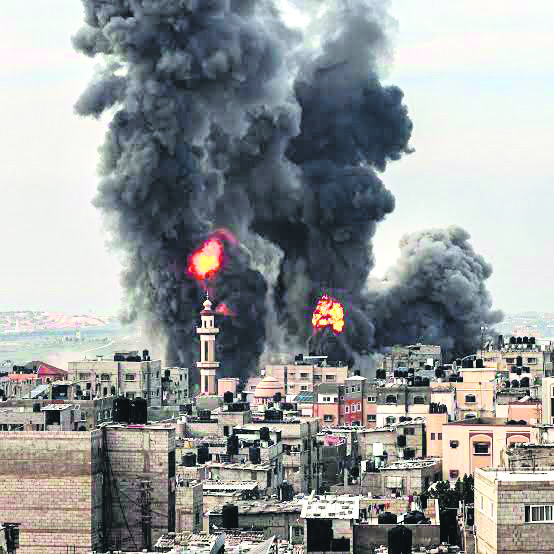The broad policy/strategic objectives of operations in Gaza could be a stable Gaza, with a broad-based government that renounces the use of terrorism to threaten Israel or the Israeli people.
INTRODUCTION
On 7 October, Israel’s long-standing security doctrine crumbled in the face of the Hamas attack. Its intelligence and military institutions were unable to keep its citizens safe. The attention of the West once again shifted to the Middle East and the Palestinian cause, and the Russia-Ukraine conflict is no longer dominating the front pages.
This war is of a different scale and significance than many previous rounds of violent confrontation in the region and will have reverberations throughout the Middle East. Ramifications of this attack and Israel’s response can no longer be localised or confined to the region and will affect Europe, West Asia, Indo-Pacific and South Asia. There is an interplay of conflict which is taking place and the US is now confronted with engagements both in Ukraine and Gaza and has to manage the consequent chaos.
THE GAZA STRIP
The Gaza Strip is one of the most densely populated areas on the planet. It’s also one of the most heavily locked down, surveilled, and suppressed. Palestinians in the West Bank and Gaza Strip have faced surveillance and controls for years, with many calling the conditions an apartheid.
In September 2021, Israeli forces completed a barrier around the Gaza Strip—that is essentially a “smart wall” equipped with radars, cameras, underground sensors, and an array of other surveillance instruments. Palestinians are subjected to multi-layered surveillance, as per Mona Shtaya, a non-resident fellow at the Tahrir Institute for Middle East Policy. Yet the Hamas was able to plan and execute an attack which shocked the world.
Hamas War Aims
Hamas was probably encouraged by the impression that Israel’s internal political crisis—sparked by extensive protests against Prime Minister Benjamin Netanyahu’s proposal to curtail the power of the Israeli Supreme Court—had diverted attention from Gaza and significantly undermined Israel’s social cohesion and military preparedness. This probably led a previously constrained Hamas to challenge the existing Israeli balance of power.
Hamas’ fundamental aspiration was to inflict harm on Israel and undermine the state. But Israeli intelligence and decision-makers felt that Hamas’ responsibilities in Gaza had tempered its extremism. Hamas encouraged this misperception, posing as a reliable actor and warning of escalation if Israel did not allow funding from Qatar to arrive in Gaza and did not permit more Gazan workers in Israel.
This failure to properly comprehend Hamas’ nature and its intentions dates back to the 2005 Israeli withdrawal from Gaza and the subsequent Hamas coup against the Palestinian Authority there. Since then, Israel operated on the premise that a deterred and weakened Hamas was preferable to a governance vacuum in Gaza and would allow Israel to focus on what it perceived as more critical strategic challenges, such as Iran’s nuclear aspirations and Hezbollah’s military build-up. Accordingly, each time a flare-up occurred in Gaza; Israel’s aim was to re-establish deterrence through a limited use of force. This allowed Hamas to carry out a long-term buildup of arms and military infrastructure and to improve its operational capabilities.
Over the years there have been viewpoints regarding being a terror organization or a governance organization. Al-Omari, who served as an advisor to the Palestinian negotiating team during the 1999-2001 permanent-status talks has said, “What we saw on October 7… is that ultimately, [terror] seems to be part of their DNA. Using terror and violence for achieving political means won the debate within Hamas.”
In the past decade, the IDF has succeeded in mitigating two central threats from Gaza: rocket attacks (which Israel’s Iron Dome defence system intercepts) and tunnels infiltrating Israeli territory (which were neutralized by an underground anti-tunnel barrier that Israel completed along the border with Gaza in 2021). But Israel failed to imagine an aboveground invasion and did not reinforce defences around Gaza in proportion to Hamas’s growing military capabilities.
ISRAEL: THE END OF STATUS QUO
From the moment Hamas broke through Israel’s security barrier with the Gaza Strip on 7 October and began its rampage, it was clear that Israel cannot return to the status quo that existed. Israelis were forced to confront the reality that many of the assumptions that had long guided Israeli policy toward the Palestinians. The state’s policy of blockading Gaza had failed to make them safe. The government’s calculation that it could lure Hamas into pragmatism, whether by allowing Qatari funding for Hamas or by giving work permits for Gaza labourers—had lured Israel into complacency. And the belief that most threats from Hamas could be neutralized by high-tech surveillance, deep underground barriers, and the Iron Dome missile defence system had proved wrong.
Its task is now to bring all the hostages back home and to make it impossible for Hamas and other adversaries, notably the Iranian-backed Lebanese militant group
Israel’s national security doctrine was initially crafted in the mid-twentieth century under the country’s first Prime Minister, David Ben-Gurion. Over the decades, it has been updated to include four main pillars: deterrence, early warning, defence, and decisive victory.
In the wake of the Hamas attack, Israel has come to see that it cannot coexist with a jihadi Islamist state at its doorstep in Gaza. The era of intermittent cycles of fighting and ceasefires in Gaza is over. What will replace it is a continuous, protracted military campaign, driven by Israel’s paramount security interests and an unwavering commitment to the safe return of the hostages being held by Hamas.
However, in the wake of the public opinion the world over following Israel’s military action and bombing of Gaza, there is an outcry against further loss of innocent lives. The question that needs to be answered is can the world move beyond the revolving pattern that has become apparent over the past two decades: support for Israel to defend itself at the onset of a conflict; followed by mounting international and domestic pressure on leaders for a ceasefire and diplomatic solutions; and Israel’s withdrawal before the completion of its objectives?
ISRAEL’S PERCEIVED STRATEGY
An effective Israeli strategy demands the integration of several interrelated, parallel endeavours—military, civilian, and political—executed methodically within a structured framework, which must be continually realigned with the expectations of the Israeli public and combined with a diplomatic campaign that will secure the assistance and support that the country will need from allies and partners.
The broad policy/strategic objectives of operations in Gaza could be a stable Gaza, with a broad-based government that renounces the use of terrorism to threaten Israel or the Israeli people. The outcomes in Gaza should convince or compel other countries in the region to cease support to terrorists. Finally, a restoration process to reach an agreement with Saudi Arabia to normalize relations with Israel, and an expansion of the Abraham Accords.
If these are the broad strategic objectives, the military objectives of Operations in Gaza which flow are to destabilize, isolate, and destroy Hamas and provide support to a new, broad-based government in Gaza. This includes destroying Hamas’ military capability and infrastructure. It must aim at protecting Israel from Gaza-based threats and attacks and
Finally destroying Hamas and its supporting nations’ terrorist networks, gathering intelligence on regional and global terrorism, capturing or kill terrorists and war criminals, and freeing hostages detained by the Hamas regime.
Plans for pushing the two million Palestinians, sheltering in South Gaza, into a small area called al-Mawasi, which is just 2.5 kilometres wide and 4 kilometres long as being reported by Paul Adams of the BBC will have disastrous humanitarian fallouts.
PALESTINIAN FRUSTRATIONS
The initiation of violence by the Hamas was triggered by the deep frustrations the Palestinians felt towards their plight. Mousa Abu Marzouk, a senior Hamas leader has been quoted in New Yorker Magazine saying, “We rolled down all of the pathways to get some of our rights—not all of them. We knocked on the door of reconciliation and we weren’t allowed in. We knocked on the door of elections and we were deprived of them. We knocked on the door of a political document for the whole world—we said, ‘We want peace, but give us some of our rights’ —but they didn’t let us in.” He added, “We tried every path; we did not find one path to take us out of our morass”.
Hamas designed its attack to bring the Palestinian issue to the fore and stoke an overreaction from Israel that would undermine international sympathy for Israel, stoke an uprising in the West Bank and Jerusalem, and rally support for Hamas, notably from Iran and Hezbollah.
Has Israel played into Hamas’ hands by the scale of its response which was inevitable? There is of course a school of thought that feels that the intensity of the Israeli reaction was necessary to prevent other non-state actors from joining in.
CONCLUSION
The attacks have revealed the failure of the idea that the Palestinian political question could be sidelined indefinitely without any cost to Israel. There had been no Israeli-Palestinian negotiations on a final status peace deal for years, even as Israel pursued normalization with a growing number of Arab states.
Over the course of more than two decades, the right-wing parties dominating the Israeli political scene had promised voters that the country was more secure than it would be under any other policy, and the majority of voters agreed. But the Hamas’ attack has crashed the status quo.
Even as fighting rages, questions abound about what happens when it finally stops.
There are many questions that need to be answered including: What can be salvaged from the wreckage? Will Hamas survive, if not as an organization, then as an ideology? Who will govern Gaza? What will be needed by both Israeli’s and Palestinians to broker any type of lasting peace?
Unfortunately, violence cannot be a solution even for an intractable conflict.

Maj Gen Jagatbir Singh, VSM (Retd) was with the Indian Army.

